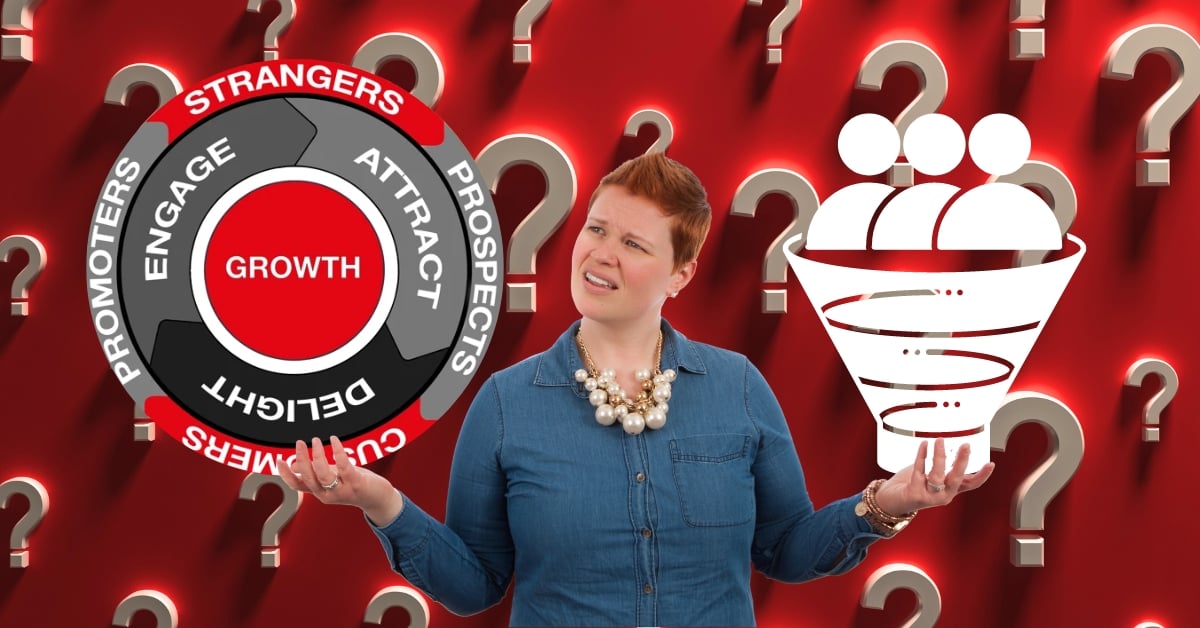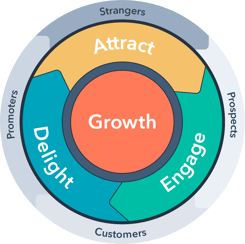Are You Using Data To Track Your Marketing Strategy?
If you use any sort of marketing strategy, you're checking the data that comes along with it, right?

If your company has goals and objectives there needs to be a system in place to help you reach them.
The funnel is the traditional model that has been used for years. And it made sense, in the fact that the amount of people to show interest in your company is much larger than the amount of people that will make it to the the final stages.
.png?width=150&name=Untitled%20design%20(24).png) A classic funnel starts big and ends small. With the large end representing your potential customers and the small end representing actual closed deals.
A classic funnel starts big and ends small. With the large end representing your potential customers and the small end representing actual closed deals.
The issue with this model is that when the customer is done with your business, you’re not doing anything to encourage them to be a repeat customer. Most likely you’re trying to find more cold leads to enter the top of the funnel. This has shown to be an inefficient way of gaining new customers because you’re constantly having to add more people to the top, with the majority of them not making it to the end of the funnel.
The idea was that what comes out of the bottom has no effect on what goes back into the top. Wrong. People talk, and the way you treat your customers matters to them. Whether they had an amazing experience or a terrible one, they will tell someone.
.png?width=98&name=eam%20go%20(2).png)
With this model, it divided the revenue generation into two teams. Marketing and sales. Marketing would own the top of the funnel and sales would take the bottom. The marketing team would try to find new leads, and the sales team would try to close those leads. If the marketing team is only worried about leads, and the sales team is only worried about hitting their revenue goals… who cares about the customer?
No one. And that shows.
The funnel stopped making sense when customers became empowered in their choices.
.png?width=133&name=eam%20go%20(3).png)
They have the ability to help your business grow, and the funnel completely forgets about that part. The amount of potential customers that are thrown to the wayside and never thought about again is a waste of your time and energy.
With the funnel model the end goal was to make a sale. That’s it. And if a prospect didn’t become a sale, they didn’t matter. It completely missed the mark on using those potential customers as momentum for your business.
.png?width=95&name=Untitled%20design%20(41).png)
Many companies will say they are customer-focused, but if they’re using the funnel model they are probably more worried about hitting their sales goals and not looking at the big picture. Growth!
Enter the flywheel model.

A flywheel is a mechanical device designed to preserve and release momentum. The momentum you gain is based on:
You may be wondering how a mechanical device can turn into a marketing tool. Let me explain.
-1.png?width=150&name=Untitled%20design%20(26)-1.png) The differing factor between flywheel and funnel is in the way your teams work together. In the funnel, as previously discussed, your two teams are working towards different goals. With the flywheel, your sales, marketing, and services teams are all working towards one shared goal. A positive customer experience. And that will naturally bring in sales. When each team is aligned on the same goal they will push your flywheel to gain momentum.
The differing factor between flywheel and funnel is in the way your teams work together. In the funnel, as previously discussed, your two teams are working towards different goals. With the flywheel, your sales, marketing, and services teams are all working towards one shared goal. A positive customer experience. And that will naturally bring in sales. When each team is aligned on the same goal they will push your flywheel to gain momentum.
The speed of the flywheel dictates how fast your company grows. And there are two elements that will affect the growth of your company…forces and friction.
You gain momentum by driving forces. You should hope to make your customers successful and create positive reinforcement so they feel compelled to share their story with others, and essentially become a promoter.
You can do this in many ways, a few are:
.png?width=150&name=Untitled%20design%20(43).png)
Forces will make your flywheel spin faster which is great for growth. The more happy customers you have, the more force will be applied. Today, 81% of buyers trust their families’ and friends’ recommendations more than companies’ business advice. That means the majority of consumers are making their purchase decisions based on reviews, and things they hear word-of-mouth.
In the same breath, you need to find the friction in your business too. Friction is anything that will slow down your flywheel. It’s something that isn’t addressed in a funnel because it doesn’t need momentum. But when looking at the flywheel and the forces that drive your growth you can also look at the pushback you’re getting. Friction can come from a few of these:
.png?width=189&name=Untitled%20design%20(28).png)
Friction can hinder all the hard work and growth you’ve made if it becomes stronger than the forces driving your momentum. In knowing this, you can take a look inward at your processes and where you’ve gone wrong.
-2.png?width=115&name=Untitled%20design%20(29)-2.png)
If your teams aren’t aligned with one another, that’s friction. If there is confusion in your customer’s buyer’s journey, that’s friction. If you don’t get back to your customers in a reasonable time frame, that’s friction.
Although momentum can be difficult to pick up, once you have it, it’s hard to stop! Taking it back to physics class, when momentum is gained it won’t stop until enough friction has been applied for a given amount of time.
.png?width=150&height=150&name=Untitled%20design%20(42).png)
Use that knowledge and data to your advantage, and find ways to add force while reducing friction at the same time.
Because the funnel is a linear model, it shows that the end doesn’t affect the beginning. The flywheel being cyclical, while focusing on the customer and how they can help your growth gives you a reminder that customer retention is just as important as bringing on new customers.
.png?width=151&name=eam%20go%20(1).png) Once you’ve started modeling your processes after a flywheel instead of a funnel, you are able to focus on customer experience and success rather than each team treating your customers like a transaction. You’ll start to build momentum for your business and begin to experience the kind of real sustainable growth that only positive and happy customers can help you create.
Once you’ve started modeling your processes after a flywheel instead of a funnel, you are able to focus on customer experience and success rather than each team treating your customers like a transaction. You’ll start to build momentum for your business and begin to experience the kind of real sustainable growth that only positive and happy customers can help you create.
If you want your flywheel to be successful, your teams must align in the end goal of your business. You are trying to take out any confusion between customer and company. Your customer should know your message and intent and see your company as a unified front.
When the customer knows they can trust you, you will start forming long lasting relationships with them. Many think that the relationship with your buyer ends with a sale, but that could be the beginning of a returning customer or promoter. Don’t let a poor customer experience drive them away. Both positive and negative interactions with your customer will affect your business.
One great way to get your teams on the same page is to get them on a shared CRM. This can act as a single source of truth between teams. Don’t forget about the potential customers that once fell through the cracks. Know where they stand… they could come back!
-1.png?width=150&name=Untitled%20design%20(31)-1.png) This is a great time to start using inbound marketing tactics and bringing your company more warm leads, giving your teams a better chance at making that end sale.
This is a great time to start using inbound marketing tactics and bringing your company more warm leads, giving your teams a better chance at making that end sale.
It's not always easy to change the way you're used to doing things. If you're having trouble implementing your flywheel, the experts at Savage Media can always help!
.jpg)
If you use any sort of marketing strategy, you're checking the data that comes along with it, right?

Ask any successful marketer and they’ll tell you that content marketing is essential to creating a marketing strategy in 2022.
%20(1).png)
In the dynamic world of service-based businesses, the quest for effective marketing strategies is relentless. As an entrepreneur, you understand the...